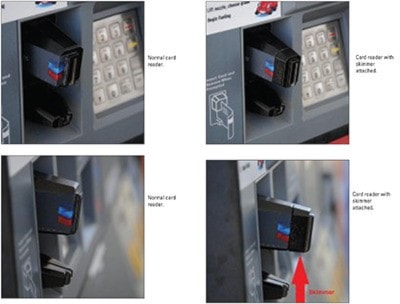By Kamloops This Week
Kamloops Mounties have released photos of a credit-card skimmer that was installed in a gas-pump payment slot in Valleyview last week.
Staff Sgt. Edward Preto said the photos are being released to make the public aware of the type of card skimmer used to capture credit-card information at the Chevron gas station at 1795 Trans-Canada Hwy. That unit has been sent to the RCMP’s technical unit for analysis, to determine if the scam netted thieves customers’ PIN numbers.
Preto said Chevron has told police it has put measures in place to prevent such incidences from happening at all Chevron gas stations in British Columbia.
As illustrated in the photographs, the skimmer is difficult to detect and appears to be a normal part of card reader. Skimmers are used by organized crime throughout Canada to access credit-card information.
Skimmed data could be used to manufacture a counterfeit card or the data could be used to make telephone or Internet purchases (also referred to as “card not present” fraud).
While a Chevron employee discovered the skimmer on July 16, Mounties did not alert the public, via the media, until July 28.
Police explained the 12-day delay by saying they did not want to cause “undue alarm if there was no risk.”
An analysis of the skimmer and a review of Chevron records should determine whether the card skimmer was able to collect data. If there was no remote download, police said it’s unlikely the scam netted any information before it was discovered.
To be certain, Mounties are advising motorists who gassed up on or shortly before July 16 to review bank and credit-card records.
Protect Yourself:
Report it:
• Step 1 – If you have charges on your credit card that you didn’t make, or if you think you may have revealed your credit card number when you shouldn’t have, contact your credit card issuer right away using the phone number on the back of your card. The card issuer will take the appropriate steps to protect you from fraud.
• Step 2 – Contact your credit bureau and have fraud alerts placed on your credit reports:
*Equifax Canada Toll free: 1-800-465-7166
*TransUnion Canada Toll free: 1-877-525-3823
• Step 3 – Contact your local police
• Step 4 – Always report credit card fraud to the Canadian Anti-Fraud Centre by visiting their website at http://www.antifraudcentre-centreantifraude.ca/index.shtm or by calling 1-888-495-8501.
Stop it:
Report a lost or stolen card as soon as you notice it’s missing. Your card issuer will cancel your card and issue you a new one.
• Make it a habit to regularly check your transactions online or on your monthly statement. If you notice charges that you didn’t make, report them to your card issuer right away.
• Never give out your card number over the phone or Internet unless you know you are dealing with a reputable company.
• Protect your personal identification number (PIN). Don’t share it with anyone or write it down. Memorize it.
• Sometimes scammers will try to trick people into revealing information about their credit cards either over the phone or through e-mail. It’s important to know that your credit card company or bank would never call to ask for personal information such as your credit card number, expiry number, PIN, or the security number on the back of your card.
• Protect your credit cards like you protect your cash. Never leave them unattended in your car or at work.
• Always check your card when it’s returned to you after a purchase. Make sure the card is yours.
• When traveling, carry your cards with you or make sure they are in a secure location such as a hotel safe.
• Sign the back of a new card as soon you get it.
• Make a list of all your cards and their numbers and keep the list in a secure place. This key information is helpful when reporting lost or stolen cards.
• Beware of all e-mail messages claiming to be from your financial institution. Canadian financial institutions do not send e-mails to their customers asking them to provide account information. In many reported cases of fraud, individuals will receive e-mail from what appears to be their bank asking them to click on a link included in the message. If you click on the link, you are brought to a fraudulent web site that looks just like your bank’s website. This practice is known as phising. When you enter personal information such as your credit card number and expiry date on a phishing site, it’s sent directly to the perpetrators of the fraud. See this website for details: http://www.rcmpgrc.gc.ca/scams-fraudes/phishing-eng.htm.
